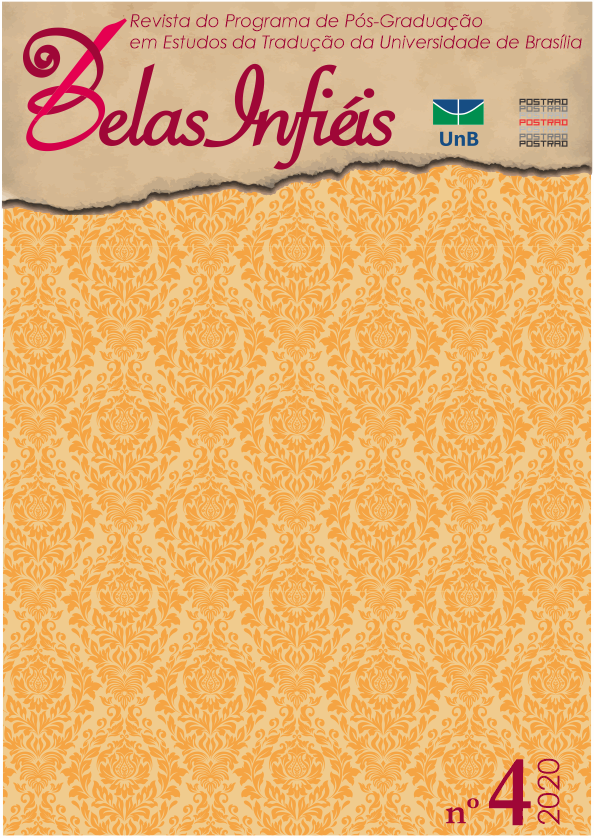Localization
DOI:
https://doi.org/10.26512/belasinfieis.v9.n4.2020.26401Keywords:
Internationalization. Localization. Translation. Software engineering.Abstract
Localization is an umbrella term that refers to the processes whereby digital content and products developed in one locale are adapted for sale and use in one or more other locales. Although the term ‘localization’ has been in use since the early 1980s, confusion persists as to what exactly it means. To understand localization, it is necessary to consider when, why and how it arose, the ways it has changed over time, and its relationship to translation and internationalization. This paper examines localization and its evolution from the 1980s to date.
Downloads
References
BARTLETT, P.G. The benefits of structured XML authoring for content management. In: Graphic Communications Association (U.S.); Organization For The Advancement Of Structured Information Systems (OASIS) (Ed.). XML 98 Conference Proceedings. Chicago, IL/New York: Graphic Communications Association, 1998. p. 15-18.
BELLAMY, Laura; CAREY, Michelle, SCHLOTFELDT, Jenifer. DITA best practices: A roadmap for writing, editing, and architecting in DITA. Upper Saddle River, NJ: IBM Press, 2012.
BIAU GIL, José R.; PYM, Anthony. Technology and translation (A pedagogical overview). In: PYM, Anthony, PEREKRESTENKO, Alexander, STARINK, Bram (Ed.). Translation technology and its teaching. Tarragona, Spain: Intercultural Studies Group, 2006. p. 5-19.
BOEHM, Barry W. Software engineering economics. Englewood Cliffs, NJ: Prentice-Hall, 1981.
CADIEUX, Pierre; ESSELINK, Bert. GILT: Globalization, Internationalization, Localization, Translation. Globalization Insider, n. 11, [s.p.], 2002.
CLARK, Dan. Beginning C# object-oriented programming. [s.e.]: Apress, 2013. doi: https://doi.org/10.1007/978-1-4302-4936-8
DEITSCH, Andy; CZARNECKI, David. Java internationalization. Sebastopol, CA: O’Reilly, 2001.
DUNNE, Keiran J. Putting the Cart behind the Horse: Rethinking localization quality management. In: DUNNE, Keiran J. (Ed.). Perspectives on localization. Amsterdam and Philadelphia: John Benjamins, 2006. p.1-11. doi: https://doi.org/10.1075/ata.xiii.08dun
DUNNE, Keiran J. Assessing software localization: For a valid approach. In: ANGELLI, Claudia V.; JACOBSON, Holly E. (Ed.). Testing and assessment in translation and interpreting studies. Amsterdam and Philadelphia: John Benjamins, 2009. p. 185-222. doi: https://doi.org/10.1075/ata.xiv.10dun
DUNNE, Keiran J.; DUNNE, Elena S. Translation and localization project management: The art of the possible. Amsterdam and Philadelphia: John Benjamins, 2011. https://doi.org/10.1075/ata.xvi
DUNNE, Keiran J. Localization. In: SIN-WAI, Chan. The Routledge encyclopedia of translation technology, 2015. p. 550-562.
ESSELINK, Bert. A Practical guide to localization. Amsterdam and Philadelphia: John Benjamins, 2000a.
ESSELINK, Bert. Translation versus localization. Tranfree, v. 10, [s.p.], 2000b.
ESSELINK, Bert. Localization engineering: The Dream Job? Revista Tradumà tica, n. 1, p. 2-5, 2002.
ESSELINK, Bert. Localisation and translation. In: SOMERS, Harold L. (Ed.). Computers and translation: A translator’s guide. Amsterdam and Philadelphia: John Benjamins, 2003a. p. 67-86. doi: https://doi.org/10.1075/btl.35.08ess
ESSELINK, Bert. The evolution of localization. The guide to localization. Supplement to MultiLingual Computing and Technology, v. 14, n. 5, p. 4-7, 2003b.
GIAMMARRESI, Salvatore. Strategic views on localization project management: The importance of global product management and portfolio management. In: DUNNE, Keiran J.; DUNNE, Elena S. (Ed.). Translation and localization project management: The art of the possible. Amsterdam and Philadelphia: John Benjamins, 2011. p. 17-49. doi: https://doi.org/10.1075/ata.xvi.03gia
HALL, Patrick A.V. Software internationalization architectures. In: KERSTEN, Gregory E., MIKOLAJUK, Zbigniew; GAR-ON YEH, Anthony. (Ed.). Decision support systems for sustainable development in developing countries: A resource book of methods and applications. Boston, MA: Kluwer Academic Publishers, 1999. p. 291-304. doi: https://doi.org/10.1007/0-306-47542-1_16
LIEU, Tina. Software localization: The art of turning Japanese. Computing Japan, v. 4, n. 12, [s.p.], 1997.
LOMMEL, Arle. The globalization industry primer. Romainmôtier, Switzerland: Localization Industry Standards Association, 2007.
LUONG, Tuoc V.; LOK, James S. H.; TAYLOR, David J.; DRISCOLL, Kevin. Internationalization: Developing software for global markets. New York: John Wiley & Sons, 1995.
MARGULIES, Benson I. Your passport to proper internationalization. Dr Dobb’s, [s.p.], 1 maio 2000.
RAYNER, Keith; SERENO, Sara C. Eye movements in reading: Psycholinguistic studies. In: GERNSBACHER, Morton A. (Ed.). Handbook of psycholinguistics. San Diego, CA: Academic Press, 1994. p. 57-81.
ROCKLEY, Ann; KOSTUR, Pamela; MANNING, Steve. Managing enterprise content: A unified content strategy. Indianapolis: New Riders, 2003.
SAVOUREL, Yves. XML internationalization and localization. Indianapolis: Sams, 2001. doi: https://doi.org/10.1162/109966202760152149
SCHMITZ, Klaus-Dirk. Indeterminacy of terms and icons in software localization. In: ANTIA, Bassey E. (Ed.). Indeterminacy in terminology and LSP. Amsterdam and Philadelphia: John Benjamins, 2007. p. 49-58. doi: https://doi.org/10.1075/tlrp.8.07sch
SMITH-FERRIER, Guy. NET internationalization: The developer’s guide to building global windows and web applications. Upper Saddle River, NJ: Addison-Wesley, 2007.
UREN, Emmanuel; HOWARD, Robert; PERINOTTI, Tiziana. Software internationalization and localization: An introduction. New York: Van Nostrand Reinhold, 1993.
VAN DER MEER, Jaap. The fate of the localization industry and a call to action. The LISA [Localization Industry Standards Association] Forum Newsletter, v. 4, n. 4, p. 14”“17, 1995.
W3C (WORLD WIDE WEB CONSORTIUM). W3C issues XML1.0 as a proposed recommendation. World Wide Web Consortium Press Release, Washington, [s.p.], 8 dez. 1997. Disponível em: http://www.w3.org/Press/ XML-PR. Acesso em: 10 mar. 2020.
Downloads
Published
How to Cite
Issue
Section
License
Copyright (c) 2020 CC BY

This work is licensed under a Creative Commons Attribution 4.0 International License.
Given the public access to this journal, the texts are free to use but requires the recognition of the original authorship and initial publication in this journal to be properly stated.
 The journal allows the use of works published for non-commercial purposes, including the right to submit the work to publicly accessible databases. Published contributions are the sole and exclusive responsibility of the author(s).Â



















